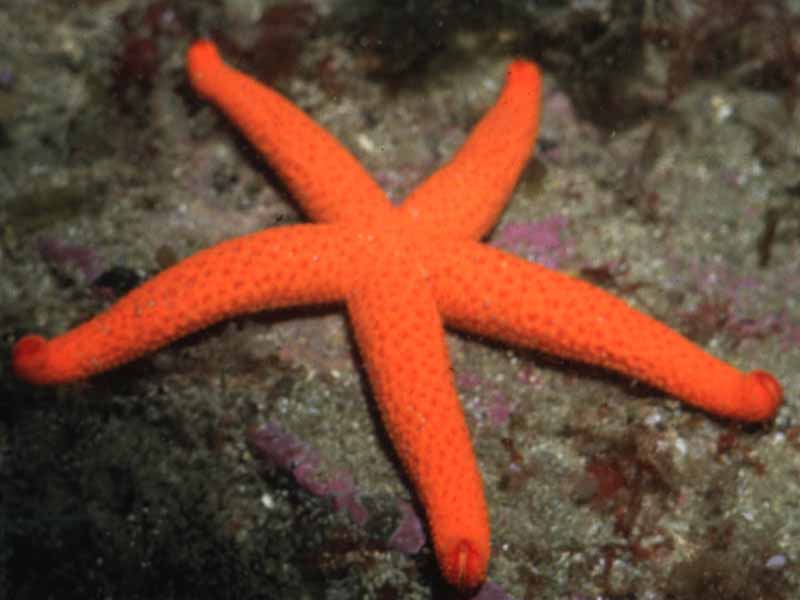Red starfish (Echinaster (Echinaster) sepositus)
Distribution data supplied by the Ocean Biodiversity Information System (OBIS). To interrogate UK data visit the NBN Atlas.Map Help
| Researched by | Kate Reeds | Refereed by | This information is not refereed |
| Authority | (Retzius, 1783) | ||
| Other common names | - | Synonyms | Echinaster sepositus |
Summary
Description
Recorded distribution in Britain and Ireland
Not recorded from the coast of mainland Britain. Recorded in the Channel Islands and on the French coast of the English Channel.Global distribution
Recorded from Brittany and into the Mediteranean and the Cape Verde Islands.Habitat
Commonly found on rocky substrata in both sheltered and moderately exposed conditions. Also found on muddy, sandy or mixed substrates and amongst eel grass beds. Not found at depths below 200 m.Depth range
-Identifying features
- Bright orange-red to brick-red in colour.
- Five to seven slender tapering arms.
- Up to 30 cm in diameter.
- Body surface has soapy texture and regular indentations.
Additional information
Similar in overall shape to Henricia oculata, but the soft, soapy surface and bright orange-red colouration are very distinctive (Picton, 1993). Adult Henricia oculata are also smaller in diameter.Listed by
- none -
Bibliography
Crothers, J. A., 1997. A key to the major groups of British marine invertebrates. Field Studies, 9, 1-177.
Hayward, P., Nelson-Smith, T. & Shields, C. 1996. Collins pocket guide. Sea shore of Britain and northern Europe. London: HarperCollins.
Hayward, P.J. & Ryland, J.S. (ed.) 1995b. Handbook of the marine fauna of North-West Europe. Oxford: Oxford University Press.
Picton, B.E., 1993. A field guide to the shallow-water echinoderms of the British Isles. London: Immel Publishing Ltd.
Southward, E.C. & Campbell, A.C., 2006. Echinoderms. The Linnean Society of London. Avon: The Bath Press. [Synopses of the British Fauna No. 56.]
Datasets
NBN (National Biodiversity Network) Atlas. Available from: https://www.nbnatlas.org.
OBIS (Ocean Biodiversity Information System), 2025. Global map of species distribution using gridded data. Available from: Ocean Biogeographic Information System. www.iobis.org. Accessed: 2025-01-02
Citation
This review can be cited as:
Last Updated: 11/10/2002



